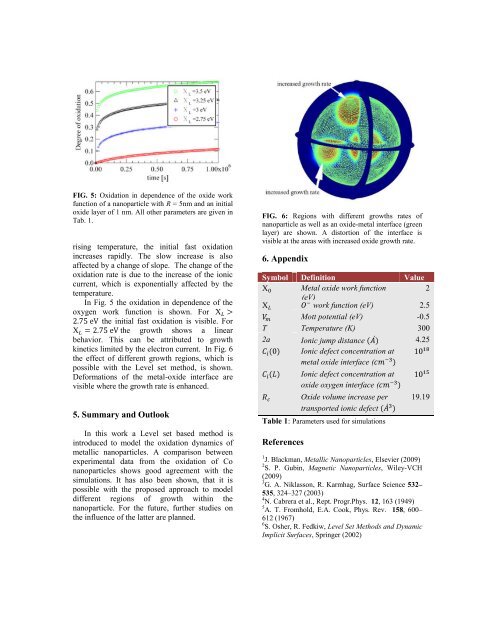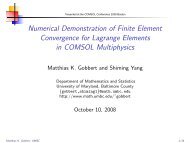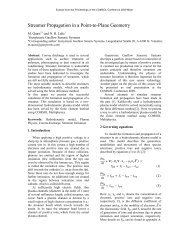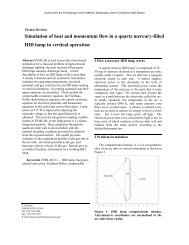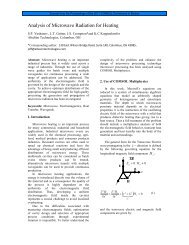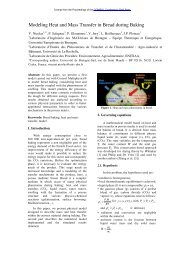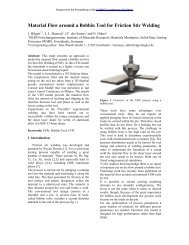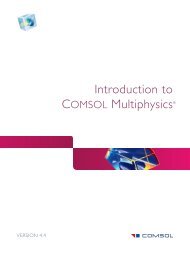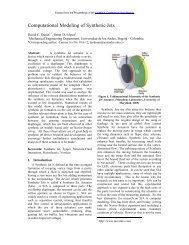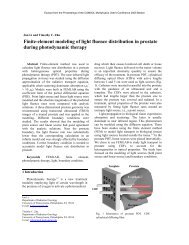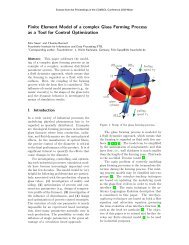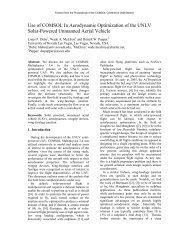Oxidation of Metallic Nanoparticles - COMSOL.com
Oxidation of Metallic Nanoparticles - COMSOL.com
Oxidation of Metallic Nanoparticles - COMSOL.com
- No tags were found...
Create successful ePaper yourself
Turn your PDF publications into a flip-book with our unique Google optimized e-Paper software.
FIG. 5: <strong>Oxidation</strong> in dependence <strong>of</strong> the oxide workfunction <strong>of</strong> a nanoparticle with R = 5nm and an initialoxide layer <strong>of</strong> 1 nm. All other parameters are given inTab. 1.rising temperature, the initial fast oxidationincreases rapidly. The slow increase is alsoaffected by a change <strong>of</strong> slope. The change <strong>of</strong> theoxidation rate is due to the increase <strong>of</strong> the ioniccurrent, which is exponentially affected by thetemperature.In Fig. 5 the oxidation in dependence <strong>of</strong> theoxygen work function is shown. Forthe initial fast oxidation is visible. Forthe growth shows a linearbehavior. This can be attributed to growthkinetics limited by the electron current. In Fig. 6the effect <strong>of</strong> different growth regions, which ispossible with the Level set method, is shown.Deformations <strong>of</strong> the metal-oxide interface arevisible where the growth rate is enhanced.5. Summary and OutlookIn this work a Level set based method isintroduced to model the oxidation dynamics <strong>of</strong>metallic nanoparticles. A <strong>com</strong>parison betweenexperimental data from the oxidation <strong>of</strong> Conanoparticles shows good agreement with thesimulations. It has also been shown, that it ispossible with the proposed approach to modeldifferent regions <strong>of</strong> growth within thenanoparticle. For the future, further studies onthe influence <strong>of</strong> the latter are planned.FIG. 6: Regions with different growths rates <strong>of</strong>nanoparticle as well as an oxide-metal interface (greenlayer) are shown. A distortion <strong>of</strong> the interface isvisible at the areas with increased oxide growth rate.6. AppendixSymbol Definition ValueMetal oxide work function 2(eV)work function (eV) 2.5Mott potential (eV) -0.5T Temperature (K) 3002a Ionic jump distance 4.25Ionic defect concentration atmetal oxide interface (Ionic defect concentration atoxide oxygen interface (Oxide volume increase pertransported ionic defectTable 1: Parameters used for simulationsReferences19.191 J. Blackman, <strong>Metallic</strong> <strong>Nanoparticles</strong>, Elsevier (2009)2 S. P. Gubin, Magnetic <strong>Nanoparticles</strong>, Wiley-VCH(2009)3 G. A. Niklasson, R. Karmhag, Surface Science 532–535, 324–327 (2003)4 N. Cabrera et al., Rept. Progr.Phys. 12, 163 (1949)5 A. T. Fromhold, E.A. Cook, Phys. Rev. 158, 600–612 (1967)6 S. Osher, R. Fedkiw, Level Set Methods and DynamicImplicit Surfaces, Springer (2002)


